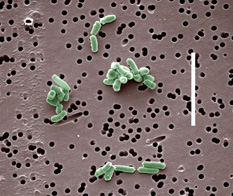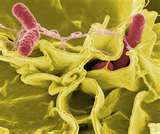Adaptation
All organisms have adaptations that help them with
some function. Their adaptations vary from organism to
organism. For instance, carnivorous animals have
enhanced legs for chasing down prey and enhanced
cephalic formation. This cephalic formation is primarily
a change in dentition that allows carnivores to tear
through meat. Furthermore, herbivores have enhanced
dentition as well. However, instead of using their teeth
to tear through meat, their teeth are specialized for
grinding so that they may break up plant material.
When it comes to bacteria, they have different types of
adaptations. Many bacteria will secrete a polysaccharide
and protein layer around themselves. This layer can be
thick, thin, rigid (capsule), or flexible (slime layer).
This layer helps bacteria resist water loss, bind to
surfaces, and resist predators.

1) Capsule
2) Slime Layer
3) Biofilm


